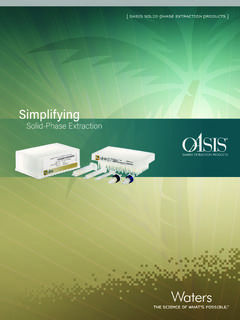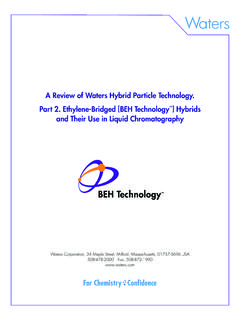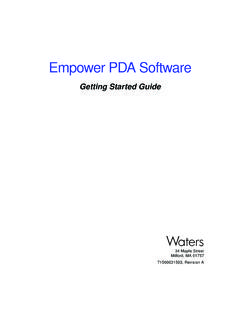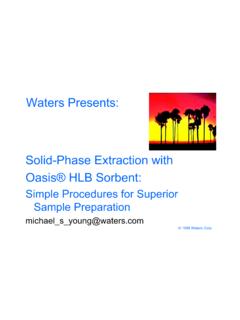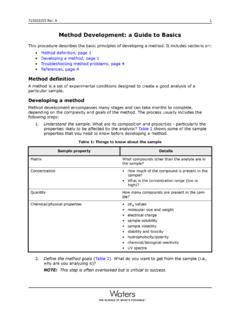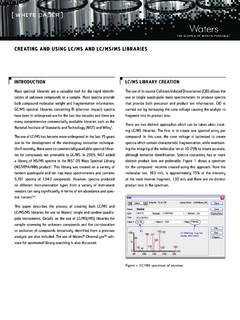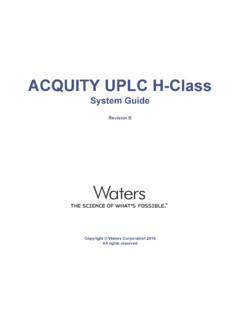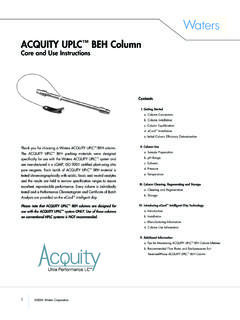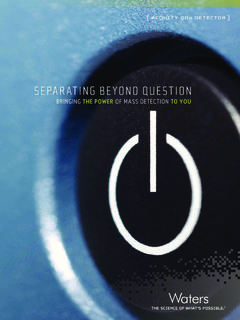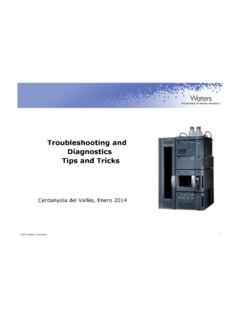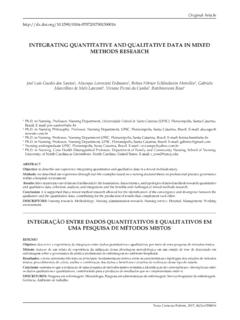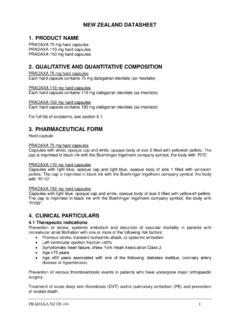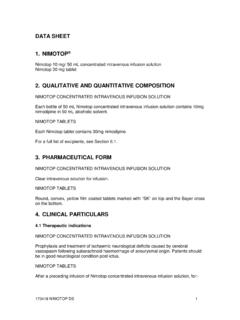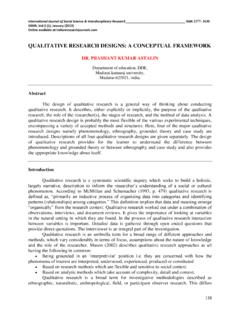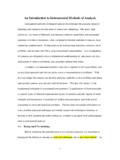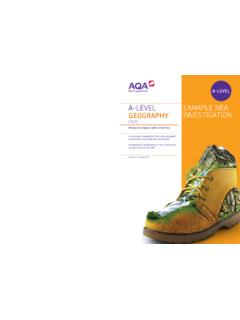Transcription of Routine UPLC-MS/MS Quantification of Pesticide …
1 1 WATERS SOLUTIONSACQUITY UPLC H-Class SystemXevo TQD ACQUITY UPLC HSS T3 Column MassLynx SoftwareKEY WORDSP esticides, okra, QuECheRS, food safetyAPPLICATION BENEFITS Multiple Pesticide residues can be detectedsimultaneously at legislative limits in okrasamples using the ACQUITY UPLC H-ClassSystem coupled with Xevo TQD MS. Quantitative and qualitative information canbe achieved in a single injection. RADAR technology enables simultaneousfull-scan data to be acquired, providingimportant information on matrix backgroundions that could potentially interfere withthe analysis.
2 PICS (product ion confirmation scan) provideadditional confirmation for compoundidentification through acquisition of MS/MSspectra in the same is an important vegetable of the tropical countries and a popular diet component in several countries including India. According to the Food and Agriculture Organization of the United Nations (FAO),1 India is one of the largest okra producers in the world and it produced approximately 5,800 tons of okra in 2010 and 2011. Okra is susceptible to a variety of pests and diseases2 and a wide-range of pesticides are used to treat okra plants in India.
3 Legislative limits are in place for the presence of pesticides in domestically produced, imported, or exported It is, therefore, very important to monitor the presence of commonly used pesticides in okra at legislative limits. According to the PRiF ( Pesticide Residues in Food) report, import controls under regulation (EC) No 669/2009 have been increased for okra imported from India because of the frequent detection of Pesticide residues, mainly monocrotophos. The consignment is supposed to be rejected if it is non-compliant with MRLs (Maximum Residue Limits).
4 Since July 1, 2012, the frequency of testing consignments has been increased from 10% to 50%. With this frequent testing, monocrotophos, triazophos, and acetamiprid were found at mg/kg in okra samples from India, while the MRL for these compounds is this application note, a multi-residue analysis method for the detection of 212 pesticides in okra is presented. For a complete list of all pesticides, see Appendix multi-residue MS method for the pesticides was created using Waters Xevo TQD Quanpedia database.
5 All of the pesticides were analyzed under ESI+ or ESI- mode using rapid polarity switching. Full-scan data were acquired in order to assess any matrix effects and the use of two MRMs and product ion confirmation scans were acquired to confirm and quantify the Pesticide residues. Routine UPLC-MS/MS Quantification of Pesticide Residues in Okra with Simultaneous Acquisition of Qualitative Full-Spectrum MS and MS/MS DataDimple Shah,1 Mark Benvenuti,1 Antonietta Gledhill,2 P. M. N. Rajesh,3 and Jennifer A. Burgess11 Waters Corporation, Milford, MA, USA2 Waters Corporation, Manchester, UK3 Waters Corporation, Bangalore, India2 Routine UPLC-MS/MS Quantification of Pesticide Residues in OkraE X P ERIMENTALUPLC conditionsLC system: ACQUITY UPLC H-Class Column: ACQUITY HSS T3 X 100 mm, mColumn temp.
6 : 45 CInjection volume: 10 LFlow rate: mL/minMobile phase A: 10 mM ammonium acetate (pH 5) in water Mobile phase B: 10 mM ammonium acetate (pH 5) in methanolWeak needle wash: 50/50 Water/methanol (v/v)Strong needle wash: 10/90 Methanol/water (v/v)Seal wash: 90/10 water/methanol Time Flow rate (min) (mL/min) %A %B Curve Initial 98 2 6 98 2 6 1 99 6 1 99 6 98 2 6 98 2 6 Table 1. UPLC method for Pesticide analysis.
7 MS conditionsMS system: Xevo TQD Ionization mode: ESI+/ESI-Capillary voltage: 3 kVDesolvation temp.: 500 CDesolvation gas flow: 1000 L/HrSource temp.: 150 CStandard preparationPesticide standards were purchased either from Sigma-Aldrich, Fisher Scientific, or AccuStandard. A mix of all pesticides at 400 ng/mL was prepared in acetonitrile and stored at 4 C. Sample preparationQuEChERS is a popular method worldwide for the multi-residue analysis of pesticides in fruits and vegetables. The AOAC official method , was used to prepare okra samples that were purchased at a local supermarket.
8 Briefly, okra samples were homogenized in water and 15 grams of homogenate was collected into a 50-mL centrifuge tube. Samples were extracted with acidified acetonitrile and mixed with MgSO4 and NaCl (Tube 1). The tube was shaken for a minute and centrifuged at 1500 rcf for 1 minute. After centrifugation, the matrix cleanup was accomplished by dispersive solid phase extraction (d-SPE) by using 50 mg of primary secondary amine (PSA), 50 mg of C18 bonded silica, 150 mg of MgSO4, and mg of graphitized carbon black (GCB).
9 5 1 mL of supernatant from Tube 1 was added to d-SPE cleanup tube and centrifuged at 1500 rcf for 1 minute. 1 mL of this extract was evaporated to dryness and reconstituted in 200 L of 40/60 acetonitrile/water spiked with internal AND DISCUSSIONAll of the pesticides were successfully detected at 10 ppb ( mg/kg) in okra sample. For all of the pesticides, Appendix A lists the ionization mode, retention time, and whether or not the compound was detected in a pre-spike 1 ppb sample, as well as the 10 ppb pre-spike sample.
10 Figure 1 shows an overlay of the total ion chromatogram (TIC) of all the pesticides at 10 ppb in okra 1. Overlay of MRM chromatograms of all pesticides at 10 ppb ( mg/kg) in UPLC-MS/MS Quantification of Pesticide Residues in OkraSolvent and matrix match spiked calibration (MMS) curves were prepared at concentrations that equated to the range 1 ppb to 50 ppb ( to mg/kg of okra) and injected in triplicate. The majority of the compounds showed linearity with R2 values greater than in both the solvent and MMS curves.
